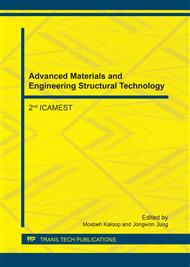[1]
R. E. Grim, Applied Clay Mineralogy, McGraw-Hill, New York, (1962).
Google Scholar
[2]
R. E. Grim, Clay Mineralogy, McGraw-Hill, New York, (1968).
Google Scholar
[3]
R. W. Grimshaw, The Chemistry and Physics of Clays, Willey-Interscience, New York, (1971).
Google Scholar
[4]
H. H. Murray, Applied Clay Mineralogy, Elsevier, Amsterdam, (2007).
Google Scholar
[5]
J. Adeyeri, Technology and Practice in Geotechnical Engineering, IGI Global, Hershe, (2014).
Google Scholar
[6]
M. Vargas, . Introduction to Soil Mechanics (Introdução à Mecânica dos Solos –Portuguese edition), McGraw-Hill do Brasil / Editora da Universidade de São, São Paulo, 1978.
DOI: 10.29381/0103-8559/20192904393-9
Google Scholar
[7]
H. Houben, H. Guillaud, Earth Construction, A comprehensive guide. Intermediate Technology Publications Ltd., Rugby, (2008).
Google Scholar
[8]
G. Minke, Earth Construction Handbook, WIT Press, Ashurst, (2006).
Google Scholar
[9]
C. S. Costa, F. Rocha, H. Varum, A. Velosa, Influence of the mineralogical composition on the properties of adobe blocks from Aveiro, Portugal. Clay Min. 48(5) (2013) 749-758.
DOI: 10.1180/claymin.2013.048.5.07
Google Scholar
[10]
A. A. R. Corrêa, V. H. Teixeira, S. P. Lopes, M. S. Oliveira, Evaluation of physical and mechanical properties of adobe brick (Avaliação das propriedades físicas e mecânicas do adobe (tijolo de terra crua), Science and Agro-Tecnology. (Ciência e Agrotecnologia – Portuguese Journal), 30(3) (2006).
DOI: 10.1590/s1413-70542006000300017
Google Scholar
[11]
D. Ciancio, P. Jaquin, P. Walker, Advances on the assessment of soil suitability for rammed earth, Construct. Build. Mater. 42 (2013) 40-47.
DOI: 10.1016/j.conbuildmat.2012.12.049
Google Scholar
[12]
O. B. Faria, B. M. Oliveira; M. Tahira, Interlaboratory tests of Proterra in Bauru-SP, Brazil. (Ensaios interlaboratoriais Proterra em Bauru-SP(Brasil). Procedings of VII Iberian American Seminar on Eart; h Architecture and Construction (VII Seminário Ibero-Americano de Arquitetura e Construção com Terra). VIISIACOT. Nov. 3-8, 2008, State University of Maranhão, São Luis, Brasil, pp.157-166.
DOI: 10.29381/0103-8559/20203001117-23
Google Scholar
[13]
C. Neves, O. Faria, Proterra Interlaboratory Tests. Adobe Essay. (Ensaios Laboratoriais de Proterra. Ensaio Adobe. ) Procedings of VII Iberian American Seminar on Eart; h Architecture and Construction (VII Seminário Ibero-Americano de Arquitetura e Construção com Terra). VIISIACOT. Nov. 3-8, 2008, State University of Maranhão, São Luis, Brasil, pp.232-241.
Google Scholar
[14]
NBR 6459, Soil – Liquid Limit Standart Test – (Determinação do Limite de liquidez) Brazilian Standard Regulation (Normas Brasileiras) 6459. Brazilian Association for Standard Aplication – (Associação Brasileira de Normas Técnicas-ABNT). Brazil, (1984).
Google Scholar
[15]
NBR 7180, Soil – Plasticity Limit Standart Test – (Determinação do Limite de liquidez) Brazilian Standard Regulation (Normas Brasileiras) 7180. . Brazilian Association for Standard Aplication – (Associação Brasileira de Normas Técnicas-ABNT). Brazil, (1984).
Google Scholar
[16]
ASTM D4318-10e1, Standard Test Methods for Liquid Limit, Plastic Limit, and Plasticity Index of Soils, ASTM International, West Conshohocken, PA, (2010).
Google Scholar
[17]
ASTM D2487-11, Standard Practice for Classification of Soils for Engineering Purposes (Unified Soil Classification System), ASTM International, West Conshohocken, PA, (2011).
Google Scholar


